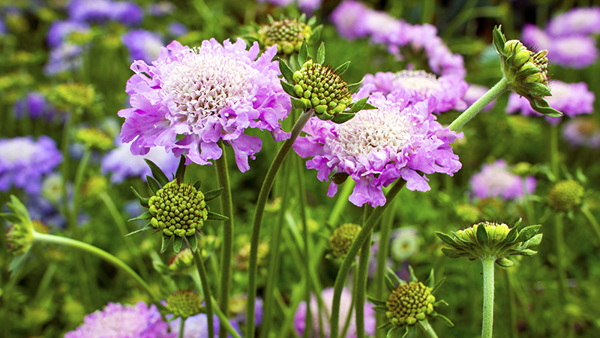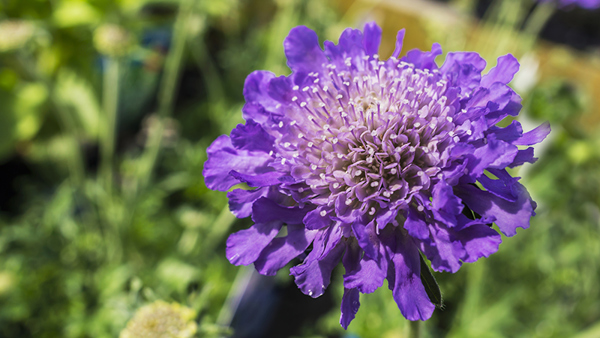Yates Account
Join now
Create a Yates account today!
Sign up to join the Yates Garden Club for monthly e-mails packed with seasonal inspiration, tips for success & exclusive promotions.
Plus if you’re a Garden Club member you can take part in the Yates Growing Community - a blog to share successes, get advice & win prizes in fun challenges along the way!

Forgot password
Enter the email address associated with your account, and we'll email you a new password.

The Pincushion Flower (Scabiosa spp.) is an old variety of cottage plant that has recently made a well-deserved comeback. A hardy and attractive plant, suited from temperate to cooler climates, these plants flower heavily from spring and into summer, attracting bees and other beneficial insects to your garden.
How to grow pincushion flowers in a garden
- Choose a sunny position in the garden and prepare the planting area well by digging in Yates Thrive Natural Blood & Bone with Seaweed.
- Dig the planting hole twice as wide and to the same depth as the root-ball. Remove the plant from the container, gently tease the roots.
- Position in hole and backfill with soil, gently firming down. Form a raised or doughnut-shaped ring of soil around the outer edge of the plant's root zone. This helps keep water where it's needed. Always water in well after planting to settle the soil around the roots and keep the soil moist for several weeks while the new plant establishes.
- Mulch around the base with organic mulch like bark chips, woodchip or pea straw, keeping it away from the base of the plant.
- Apply Yates Thrive Rose & Flower Granular Plant Food from spring until mid-autumn to promote good soil health and plant growth. TIP: For an added boost, apply Yates Thrive Fish Blood & Bone Plant Food Concentrate.


How to grow pincushion flowers in a pot
- Choose a pot at least 200 mm wide. Position in full sun or part shade and protect from strong winds.
- Fill chosen pots with quality potting mix, such as Yates Premium Potting Mix.
- Remove the plant from the container, gently tease the roots. Position in hole and backfill with potting mix, gently firming down. Water in well.
- During the flowering period, feed every 1 to 2 weeks with Yates Thrive Roses & Flowers Liquid Plant Food. TIP: For an added boost, apply Yates Thrive Fish Blood & Bone Plant Food Concentrate.
Growing tips
- Scabiosa are fantastic and hardy cottage style plants, adding splashes of colour where needed to your gardens and pots.
- Happy in full sun where they will flower heavily. They will form a clump and flower for many years.
- Prune lightly and remove spent flowers as required to encourage new flowers. Feed regularly to keep them flourishing.
- Great used in a mixed cottage garden, where they add colour and bright splashes where ever they are planted.
- Mix with salvia, daisies, lavender and other cottage perennials to give year-round colour and interest.
Orange trumpet vine, with its brilliant cascading masses of orange tubular flowers, is one of the most spectacular winter flowering climbers.
Spring Stars
Spring Stars are a versatile addition to any garden with delightful lavender-blue, star shaped blooms.
Flax
Flaxes (Phormium spp.) are highly versatile plants which don't mind swampy or dry conditions. Great for large pots or planted en-masse in garden beds.
Proteas
Not just any old blossom, protea flowers are blooms with attitude. If you can give them full sun and reasonable drainage, proteas will love you.
Recommended products
Yates Thrive Natural Blood & Bone with Seaweed
A certified organic garden input boosted with NZ Seaweed to gently nourish plants, enrich the soil and encourage a strong healthy root system.
Yates Thrive Rose & Flower Granular Plant Food
Specially formulated to grow all types of flowers. With high potassium for large & abundant flowers, added calcium & iron for stronger flowers.
Yates Premium Potting Mix
A premium potting mix, ideal for all potted plants and shrubs, including ornamentals, fruit trees, vegies and herbs.
Yates Thrive Fish Blood & Bone Plant Food Concentrate
A balanced fish based plant food boosted wtih added NPK to ensure strong, lush plant growth and healthy soil.
















Share
Share this article on social media